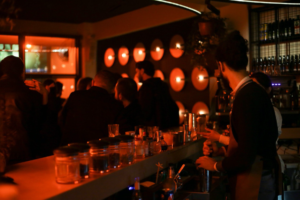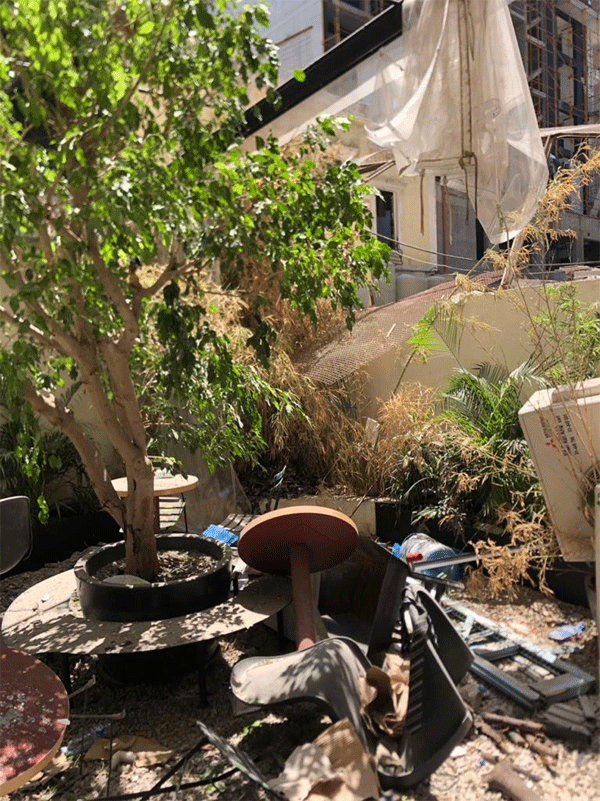I was sent this article by Hester Moore, who spoke to the Tuesday Club last year:

Around the end of 2018, my friends opened a cozy bar – Tenno – in a lively elbow of our Beirut neighborhood, Mar Mikhail. It edges the city’s historic Armenian quarter, and the main artery of Armenia Street that runs through it is a cacophony of car horns; music spilling out of bars; the smell of roasting cinnamon and elegant ingredients making marriages of cocktails. Splendid Ottoman and French houses framed Armenia Street in a variety of pastel colours, winding balconies and soaring triple-arch windows. People – young, bright, interesting, zany, some queer, some not, some unsure, all glowing – sat on street corners with cigarette smoke curling around conversations until late in the night. I’d duck down a flight of perilously steep steps from my place overlooking Mar Mikhail, curve my way down Armenia Street running into conversations, cars, cocktails; and take cover amongst friends in Tenno’s crimson light.
There’s a series of photographs of us in Tenno that spans the time between when it opened and when it was destroyed. There’s the evolution of friendships – different faces captured in various shades of joy, rhapsody, deep contemplation, wild dancing, imbibing, gastronomy, togetherness – there’s also the tinder and burn of the October 2019 revolution, the creep of pandemic-related lockdowns, the fierce resistance against stifling economic stagnation across the country. Tenno and a close huddle of neighbourhood establishments weathered electricity blackouts – at a time when the chronic mismanagement of the country plunged Lebanon into darkness for sometimes 20 hours a day – the uncertainty of the future punctured, miraculously, by ice cubes clinking around tall glasses and raucous laughter sweeping around the courtyard.
What’s uncaptured across this series is nearly 3000 tonnes of ammonium nitrate that sat only a kilometer away as we were drowned, in a happy ignorance, by the beat of the neighborhood. Only the government knew about that, then.
In Christchurch last week, I met Garry at another intersection punctuated by roadworks, and he asked me what you’re like. I wrestled with distilling all of your layers into a few pithy, attractive lines. How? I asked; however many words it takes to tell a good story, he responded – and I wonder how many, which words, who, what stories, are enough or too much or too little to measure something that feels immeasurable? How do I capture the depths of this injury – that every friend of mine is displaced and hurt; that the billions of shards of glass lying in the streets are being swept aside by the people they punctured – not the government that shattered them; that the bars and restaurants we filled with laughter, friends, and tender moments are now fractured jigsaw pieces strewn over the streets?
I remember the reckoning that followed in the weeks and months after the earthquake here in Christchurch. It was a slow burning grief that drifted between our memories of those fond disappeared spaces. We pondered where to keep our sadness; underneath and in between the piles of fallen bricks, there were entire chapters of our lives. The loss of the places in which these were written felt as injurious as if somebody had erased the words entirely. As a new face of Christchurch was plastered over the rubble of the old, these memories slipped into the silt, kept there by the people who’d made them and secrets to whoever came after.
In Beirut, my friends are bloodied, bruised, and scarred – and gluing back together the pieces left by the explosion. They return, every day, to Tenno and valiantly deconstruct the mess of collapsed ceilings, walls, upended furniture. They salvaged what they could and piled the façade high with cement bricks to prevent looting. Israeli style, my friend Moe called it, who buoys our way through this with an endless spring of optimism and wit. I see footage of them armed with brooms, dustpans, ladders; stalking the streets, moving house-to-house sweeping aside the destruction into well-organized piles. They’re slowly rebuilding Tenno. There is no government, no insurance, no Student Volunteer Army to come and help out. They, like so many others left in the rubble of this disaster, are relying on a distraught community to get them back on their feet. Beirut is reeling, though; and this community needs to be a global one.
Here’s how the bar which was in the photo above ended up:

Our memories are framed now in pictures of cities disappeared. They seem precious for that. But Christchurch, and Beirut, lived and will live again. Through support, through community, through aroha – Tenno will house new memories, and the indestructible artery will pump into life. It’ll rush the streets with an incessant chatter, motorbikes roaring and eyes rolling, mists of family dinners rising from windows, punctuated laughter in narrow, uneven streets as a thousand different stereos capture every beat and you, Beirut, are grinning a seductive crimson smile and your mouth is full with people, people, people.
He aha te mea nui o te ao?
He Tangata, He Tangata, He Tangata.
To donate to Tenno’s second life, please visit https://www.gofundme.com/f/help-us-rebuild-tenno
To donate to Beirut-based charities, visit https://www.justgiving.com/fundraising/lebanon-relief
Hester lived in Beirut until March 2020, where she worked for the Office of the United Nations High Commissioner for Refugees (UNHCR).
Leave a Reply